Exhibit 99.3
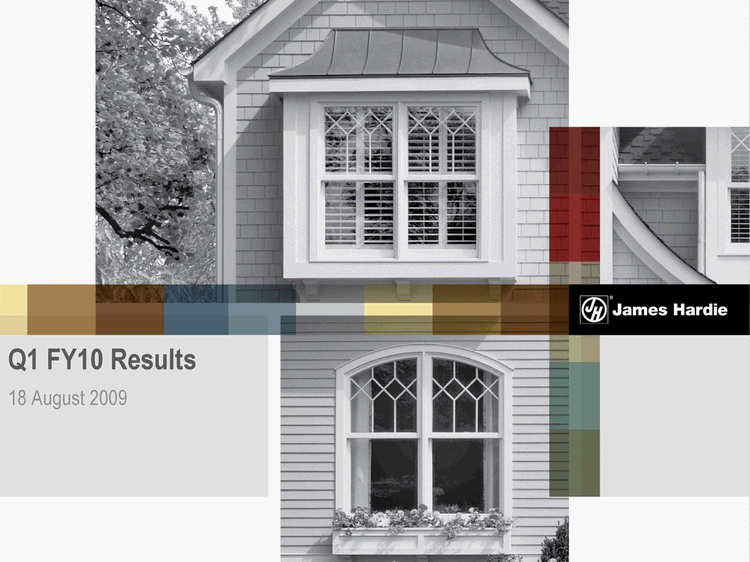
| 18 August 2009 Q1 FY10 Results |

| 18 August 2009 Q1 FY10 Results |
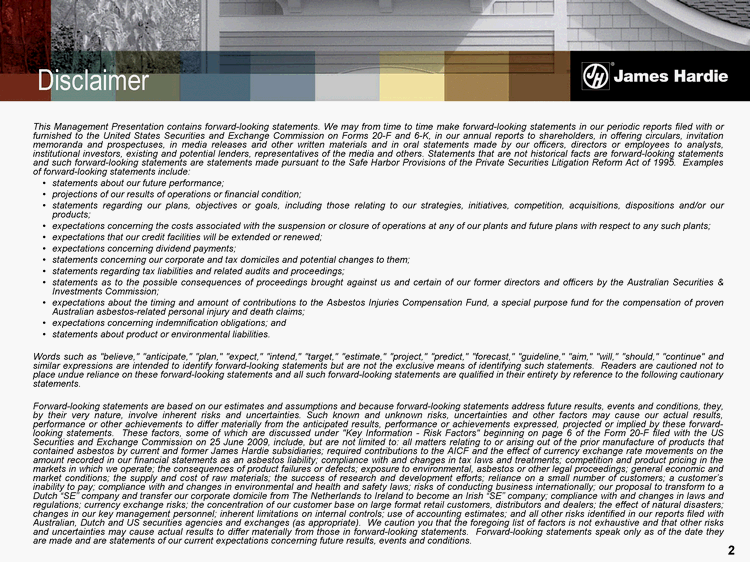
| 2 Disclaimer This Management Presentation contains forward-looking statements. We may from time to time make forward-looking statements in our periodic reports filed with or furnished to the United States Securities and Exchange Commission on Forms 20-F and 6-K, in our annual reports to shareholders, in offering circulars, invitation memoranda and prospectuses, in media releases and other written materials and in oral statements made by our officers, directors or employees to analysts, institutional investors, existing and potential lenders, representatives of the media and others. Statements that are not historical facts are forward-looking statements and such forward-looking statements are statements made pursuant to the Safe Harbor Provisions of the Private Securities Litigation Reform Act of 1995. Examples of forward-looking statements include: statements about our future performance; projections of our results of operations or financial condition; statements regarding our plans, objectives or goals, including those relating to our strategies, initiatives, competition, acquisitions, dispositions and/or our products; expectations concerning the costs associated with the suspension or closure of operations at any of our plants and future plans with respect to any such plants; expectations that our credit facilities will be extended or renewed; expectations concerning dividend payments; statements concerning our corporate and tax domiciles and potential changes to them; statements regarding tax liabilities and related audits and proceedings; statements as to the possible consequences of proceedings brought against us and certain of our former directors and officers by the Australian Securities & Investments Commission; expectations about the timing and amount of contributions to the Asbestos Injuries Compensation Fund, a special purpose fund for the compensation of proven Australian asbestos-related personal injury and death claims; expectations concerning indemnification obligations; and statements about product or environmental liabilities. Words such as "believe," "anticipate," "plan," "expect," "intend," "target," "estimate," "project," "predict," "forecast," "guideline," "aim," "will," "should," "continue" and similar expressions are intended to identify forward-looking statements but are not the exclusive means of identifying such statements. Readers are cautioned not to place undue reliance on these forward-looking statements and all such forward-looking statements are qualified in their entirety by reference to the following cautionary statements. Forward-looking statements are based on our estimates and assumptions and because forward-looking statements address future results, events and conditions, they, by their very nature, involve inherent risks and uncertainties. Such known and unknown risks, uncertainties and other factors may cause our actual results, performance or other achievements to differ materially from the anticipated results, performance or achievements expressed, projected or implied by these forward- looking statements. These factors, some of which are discussed under "Key Information - Risk Factors" beginning on page 6 of the Form 20-F filed with the US Securities and Exchange Commission on 25 June 2009, include, but are not limited to: all matters relating to or arising out of the prior manufacture of products that contained asbestos by current and former James Hardie subsidiaries; required contributions to the AICF and the effect of currency exchange rate movements on the amount recorded in our financial statements as an asbestos liability; compliance with and changes in tax laws and treatments; competition and product pricing in the markets in which we operate; the consequences of product failures or defects; exposure to environmental, asbestos or other legal proceedings; general economic and market conditions; the supply and cost of raw materials; the success of research and development efforts; reliance on a small number of customers; a customer's inability to pay; compliance with and changes in environmental and health and safety laws; risks of conducting business internationally; our proposal to transform to a Dutch "SE" company and transfer our corporate domicile from The Netherlands to Ireland to become an Irish "SE" company; compliance with and changes in laws and regulations; currency exchange risks; the concentration of our customer base on large format retail customers, distributors and dealers; the effect of natural disasters; changes in our key management personnel; inherent limitations on internal controls; use of accounting estimates; and all other risks identified in our reports filed with Australian, Dutch and US securities agencies and exchanges (as appropriate). We caution you that the foregoing list of factors is not exhaustive and that other risks and uncertainties may cause actual results to differ materially from those in forward-looking statements. Forward-looking statements speak only as of the date they are made and are statements of our current expectations concerning future results, events and conditions. |
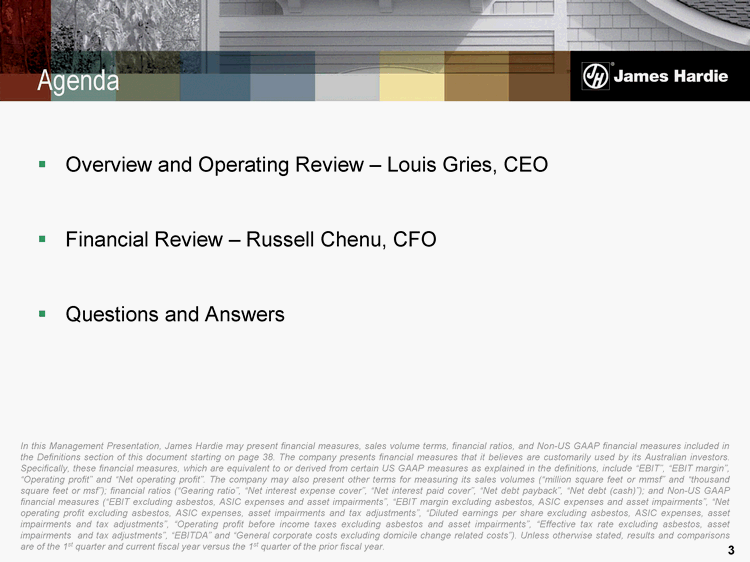
| 3 Overview and Operating Review - Louis Gries, CEO Financial Review - Russell Chenu, CFO Questions and Answers Agenda In this Management Presentation, James Hardie may present financial measures, sales volume terms, financial ratios, and Non-US GAAP financial measures included in the Definitions section of this document starting on page 38. The company presents financial measures that it believes are customarily used by its Australian investors. Specifically, these financial measures, which are equivalent to or derived from certain US GAAP measures as explained in the definitions, include "EBIT", "EBIT margin", "Operating profit" and "Net operating profit". The company may also present other terms for measuring its sales volumes ("million square feet or mmsf" and "thousand square feet or msf"); financial ratios ("Gearing ratio", "Net interest expense cover", "Net interest paid cover", "Net debt payback", "Net debt (cash)"); and Non-US GAAP financial measures ("EBIT excluding asbestos, ASIC expenses and asset impairments", "EBIT margin excluding asbestos, ASIC expenses and asset impairments", "Net operating profit excluding asbestos, ASIC expenses, asset impairments and tax adjustments", "Diluted earnings per share excluding asbestos, ASIC expenses, asset impairments and tax adjustments", "Operating profit before income taxes excluding asbestos and asset impairments", "Effective tax rate excluding asbestos, asset impairments and tax adjustments", "EBITDA" and "General corporate costs excluding domicile change related costs"). Unless otherwise stated, results and comparisons are of the 1st quarter and current fiscal year versus the 1st quarter of the prior fiscal year. |
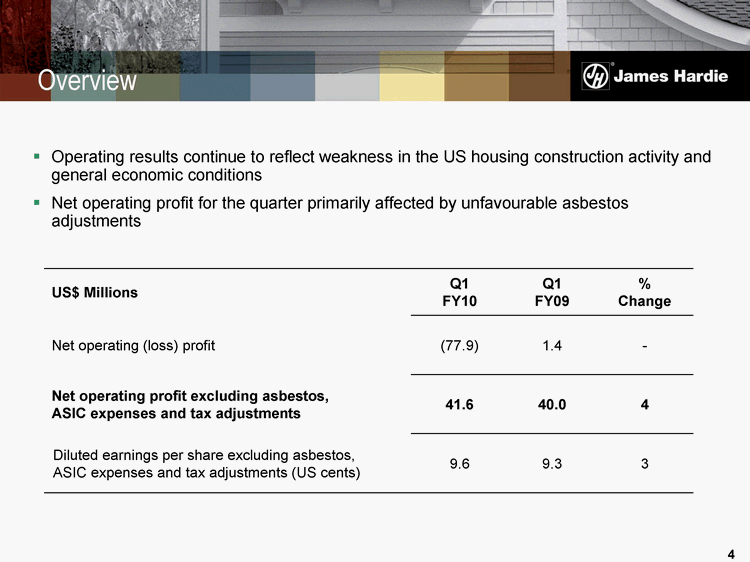
| 4 Overview Operating results continue to reflect weakness in the US housing construction activity and general economic conditions Net operating profit for the quarter primarily affected by unfavourable asbestos adjustments US$ Millions Q1 FY10 Q1 FY09 % Change Net operating (loss) profit (77.9) 1.4 - Net operating profit excluding asbestos, ASIC expenses and tax adjustments 41.6 40.0 4 Diluted earnings per share excluding asbestos, ASIC expenses and tax adjustments (US cents) 9.6 9.3 3 |
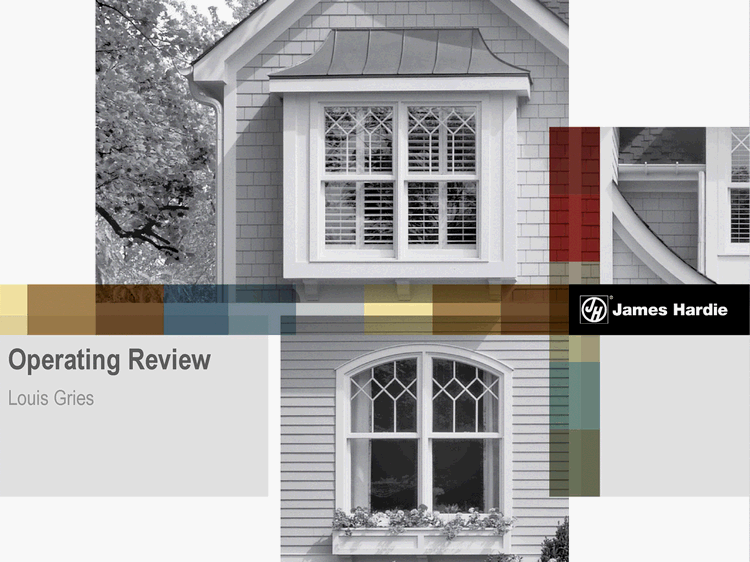
| Louis Gries Operating Review |
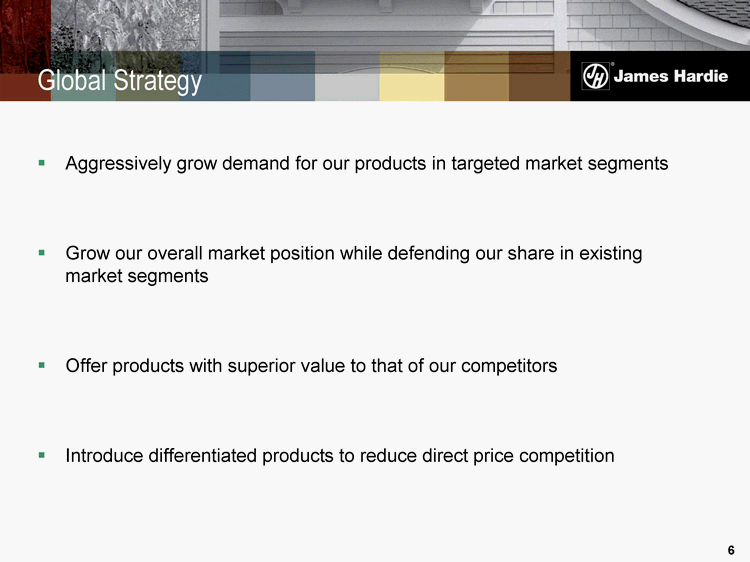
| 6 Aggressively grow demand for our products in targeted market segments Grow our overall market position while defending our share in existing market segments Offer products with superior value to that of our competitors Introduce differentiated products to reduce direct price competition Global Strategy |

| 7 1st Quarter Result * Net Sales down 21% to US$219.1 million Sales Volume down 24% to 353.7 mmsf Average Price up 4% to US$619 per msf EBIT up 5% to US$68.6 million EBIT Margin up 7.4 pts to 31.3% USA Fibre Cement *Comparison is of the 1st quarter of the current fiscal year versus the 1st quarter of the prior fiscal year |
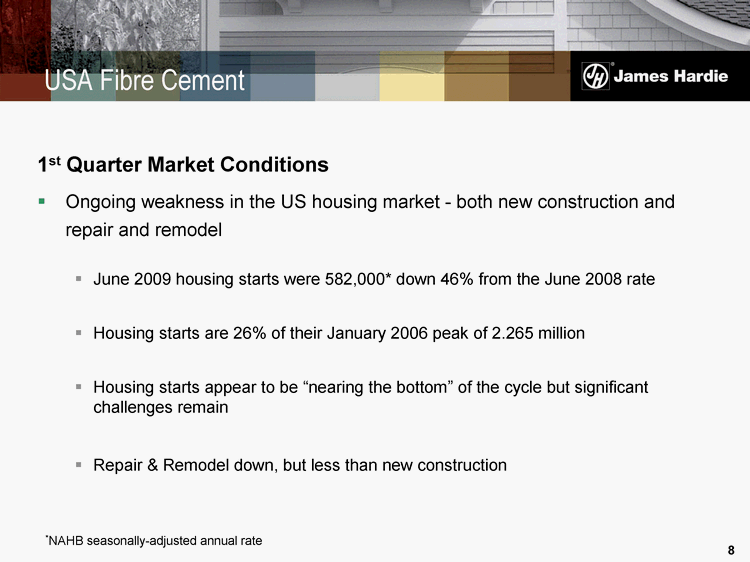
| 8 1st Quarter Market Conditions Ongoing weakness in the US housing market - both new construction and repair and remodel June 2009 housing starts were 582,000* down 46% from the June 2008 rate Housing starts are 26% of their January 2006 peak of 2.265 million Housing starts appear to be "nearing the bottom" of the cycle but significant challenges remain Repair & Remodel down, but less than new construction USA Fibre Cement *NAHB seasonally-adjusted annual rate |
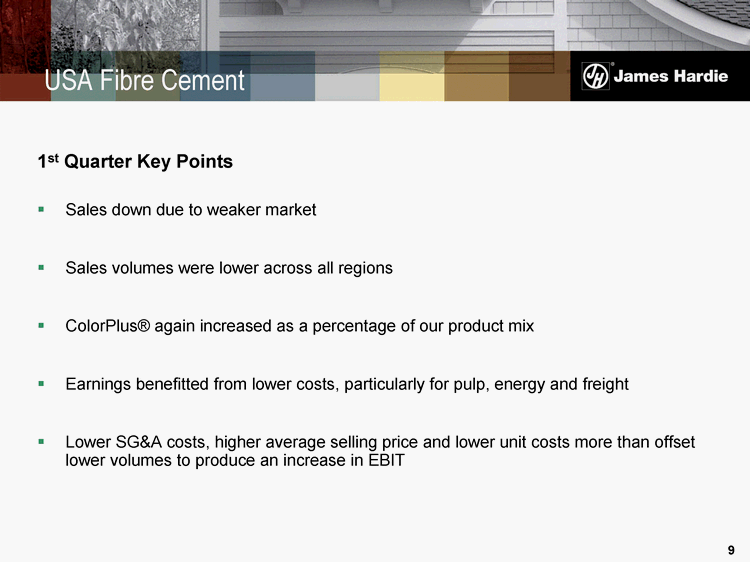
| 9 1st Quarter Key Points Sales down due to weaker market Sales volumes were lower across all regions ColorPlus(r) again increased as a percentage of our product mix Earnings benefitted from lower costs, particularly for pulp, energy and freight Lower SG&A costs, higher average selling price and lower unit costs more than offset lower volumes to produce an increase in EBIT USA Fibre Cement |
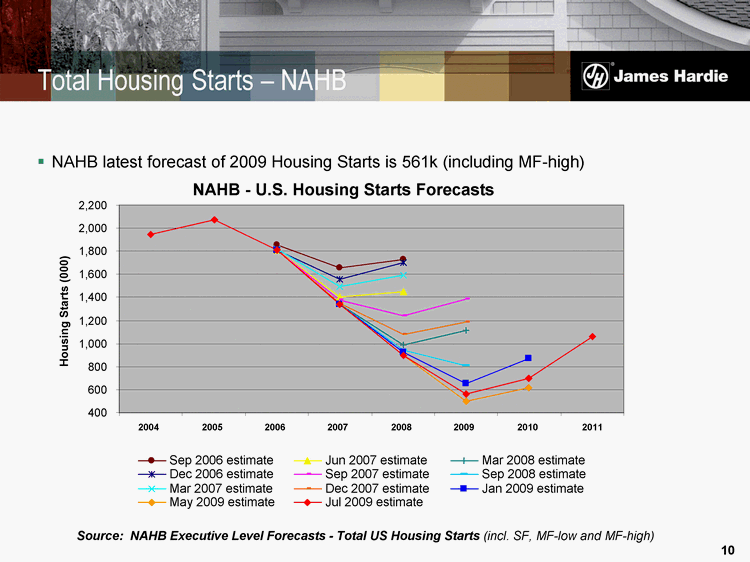
| 10 Total Housing Starts - NAHB NAHB latest forecast of 2009 Housing Starts is 561k (including MF-high) Source: NAHB Executive Level Forecasts - Total US Housing Starts (incl. SF, MF-low and MF-high) May 2009 estimate Jul 2009 estimate |
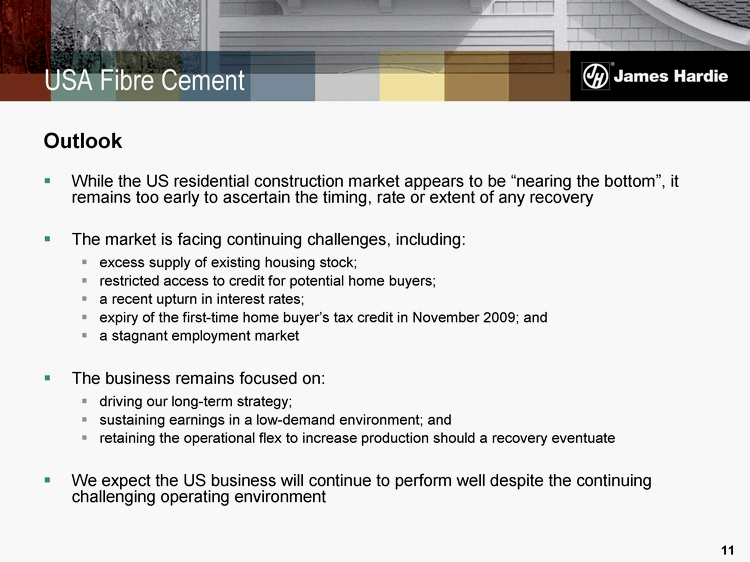
| 11 Outlook While the US residential construction market appears to be "nearing the bottom", it remains too early to ascertain the timing, rate or extent of any recovery The market is facing continuing challenges, including: excess supply of existing housing stock; restricted access to credit for potential home buyers; a recent upturn in interest rates; expiry of the first-time home buyer's tax credit in November 2009; and a stagnant employment market The business remains focused on: driving our long-term strategy; sustaining earnings in a low-demand environment; and retaining the operational flex to increase production should a recovery eventuate We expect the US business will continue to perform well despite the continuing challenging operating environment USA Fibre Cement |
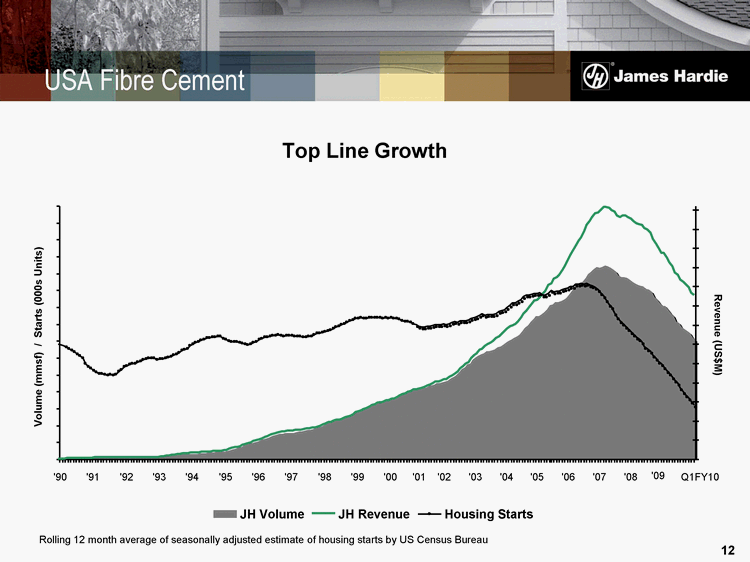
| 12 USA Fibre Cement Rolling 12 month average of seasonally adjusted estimate of housing starts by US Census Bureau Top Line Growth '90 '91 '92 '93 '94 '95 '96 '97 '98 '99 '00 '01 '02 '03 '04 '05 '06 '07 '08 Q1FY10 Volume (mmsf) / Starts (000s Units) $0 Revenue (US$M) JH Volume JH Revenue Housing Starts '09 |

| 13 USA Fibre Cement Primary Growth Performance Sources: Dodge US addressable starts (SF & MF-low); US Census R&R $ expenditures less CPI Note: • US Census discontinued their R&R $ expenditures report in 2007 • 2008 R&R = avg. published Home Depot & Lowe's same store sales less CPI |
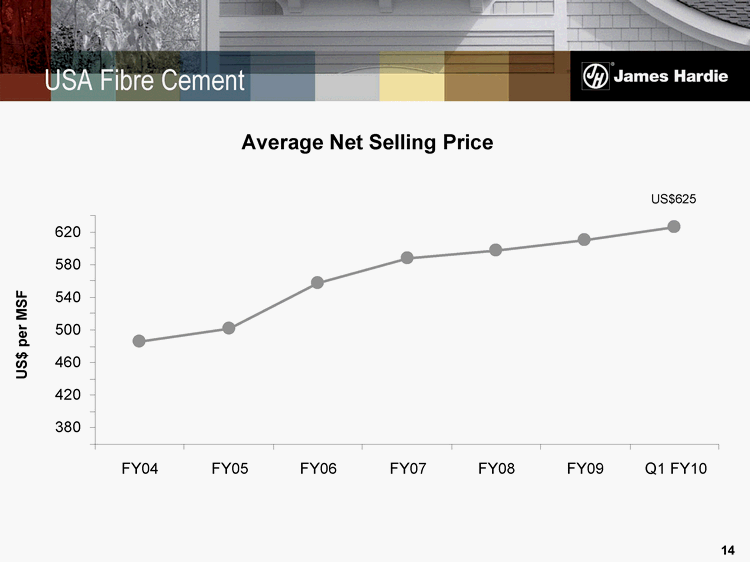
| 14 Average Net Selling Price US$ per MSF USA Fibre Cement 380 420 460 500 540 580 620 FY04 FY05 FY06 FY07 FY08 FY09 Q1 FY10 US$625 |
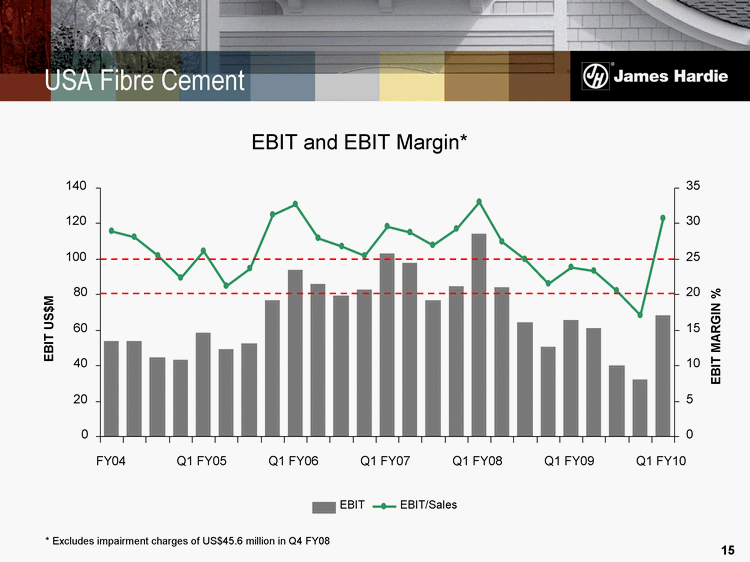
| 15 USA Fibre Cement 0 20 40 60 80 100 120 140 FY04 Q1 FY05 Q1 FY06 Q1 FY07 Q1 FY08 Q1 FY09 Q1 FY10 EBIT US$M 0 5 10 15 20 25 30 35 EBIT MARGIN % EBIT EBIT/Sales EBIT and EBIT Margin* * Excludes impairment charges of US$45.6 million in Q4 FY08 |
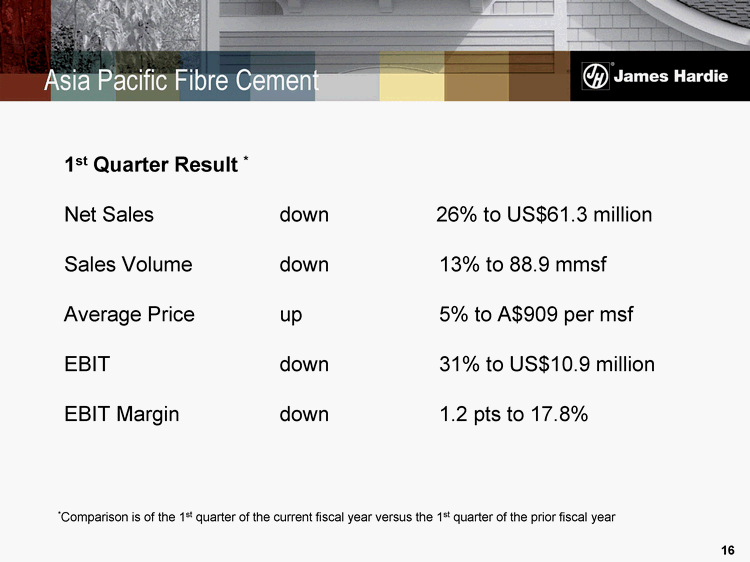
| 16 1st Quarter Result * Net Sales down 26% to US$61.3 million Sales Volume down 13% to 88.9 mmsf Average Price up 5% to A$909 per msf EBIT down 31% to US$10.9 million EBIT Margin down 1.2 pts to 17.8% Asia Pacific Fibre Cement *Comparison is of the 1st quarter of the current fiscal year versus the 1st quarter of the prior fiscal year |

| 17 1st Quarter Key Points Business performed well in a difficult operating environment In Australian dollars, Asia Pacific net sales down 8% due to 13% decrease in sales volume, partially offset by a 5% increase in average net sales price In Australian dollars, Asia Pacific Fibre Cement EBIT for the quarter decreased 13% due to a lower gross margin performance partially offset by lower SG&A expenses Australian residential approvals down 18% in June 2009 quarter, compared to June 2008 quarter New Zealand housing consents remain at 25-year lows Continued growth in sales of differentiated products in Australia and New Zealand Asia Pacific Fibre Cement |
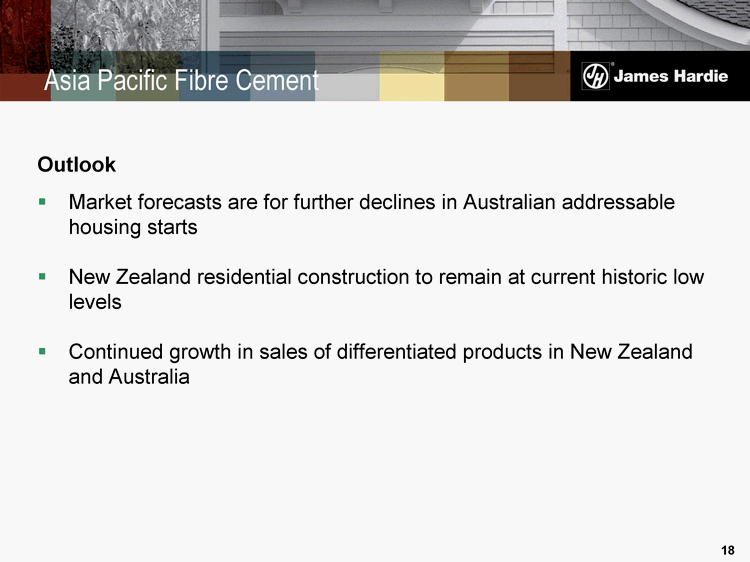
| 18 Outlook Market forecasts are for further declines in Australian addressable housing starts New Zealand residential construction to remain at current historic low levels Continued growth in sales of differentiated products in New Zealand and Australia Asia Pacific Fibre Cement |

| Russell Chenu Financial Review |
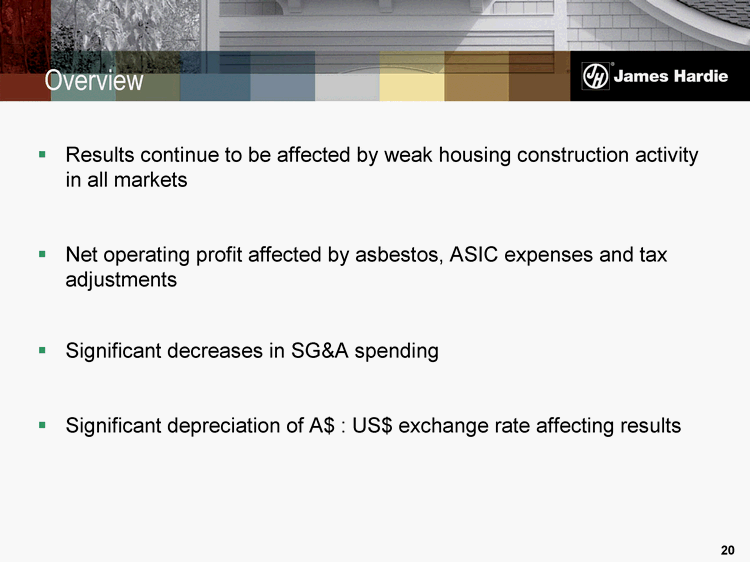
| 20 Overview Results continue to be affected by weak housing construction activity in all markets Net operating profit affected by asbestos, ASIC expenses and tax adjustments Significant decreases in SG&A spending Significant depreciation of A$ : US$ exchange rate affecting results |
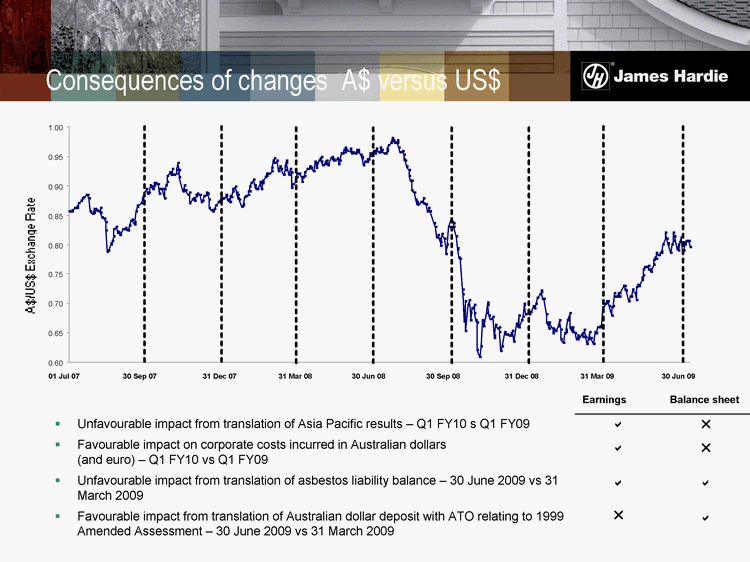
| Consequences of changes A$ versus US$ Unfavourable impact from translation of Asia Pacific results - Q1 FY10 s Q1 FY09 Favourable impact on corporate costs incurred in Australian dollars (and euro) - Q1 FY10 vs Q1 FY09 Unfavourable impact from translation of asbestos liability balance - 30 June 2009 vs 31 March 2009 Favourable impact from translation of Australian dollar deposit with ATO relating to 1999 Amended Assessment - 30 June 2009 vs 31 March 2009 Earnings Balance sheet ? ? ? ? ? ? ? ? 0.60 0.65 0.70 0.75 0.80 0.85 0.90 0.95 1.00 01 Jul 07 30 Sep 07 31 Dec 07 31 Mar 08 30 Jun 08 30 Sep 08 31 Dec 08 31 Mar 09 30 Jun 09 |
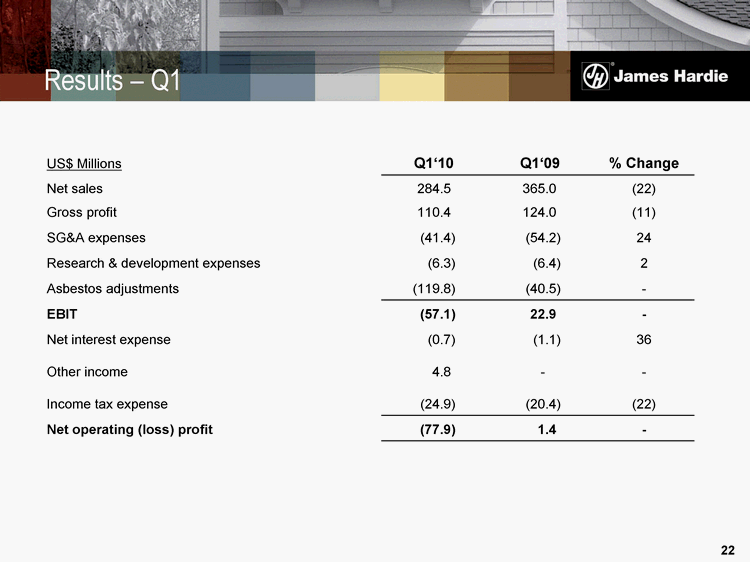
| 22 Results - Q1 US$ Millions Q1'10 Q1'09 % Change Net sales 284.5 365.0 (22) Gross profit 110.4 124.0 (11) SG&A expenses (41.4) (54.2) 24 Research & development expenses (6.3) (6.4) 2 Asbestos adjustments (119.8) (40.5) - EBIT (57.1) 22.9 - Net interest expense (0.7) (1.1) 36 Other income 4.8 - - Income tax expense (24.9) (20.4) (22) Net operating (loss) profit (77.9) 1.4 - |
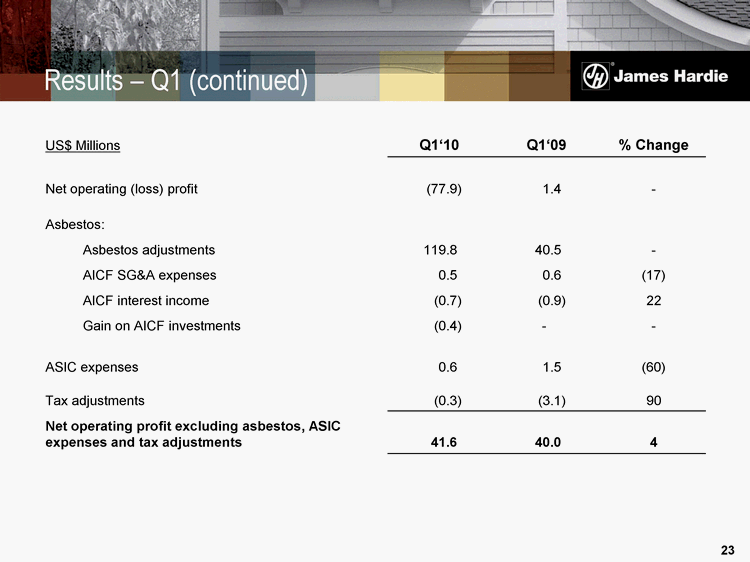
| 23 Results - Q1 (continued) US$ Millions Q1'10 Q1'09 % Change Net operating (loss) profit (77.9) 1.4 - Asbestos: Asbestos adjustments 119.8 40.5 - AICF SG&A expenses 0.5 0.6 (17) AICF interest income (0.7) (0.9) 22 Gain on AICF investments (0.4) - - ASIC expenses 0.6 1.5 (60) Tax adjustments (0.3) (3.1) 90 Net operating profit excluding asbestos, ASIC expenses and tax adjustments 41.6 40.0 4 |
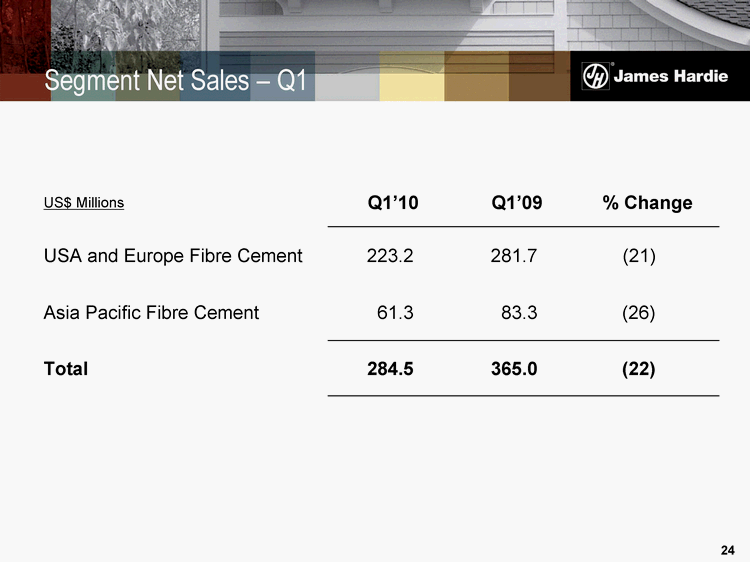
| 24 US$ Millions Q1'10 Q1'09 % Change USA and Europe Fibre Cement 223.2 281.7 (21) Asia Pacific Fibre Cement 61.3 83.3 (26) Total 284.5 365.0 (22) Segment Net Sales - Q1 |
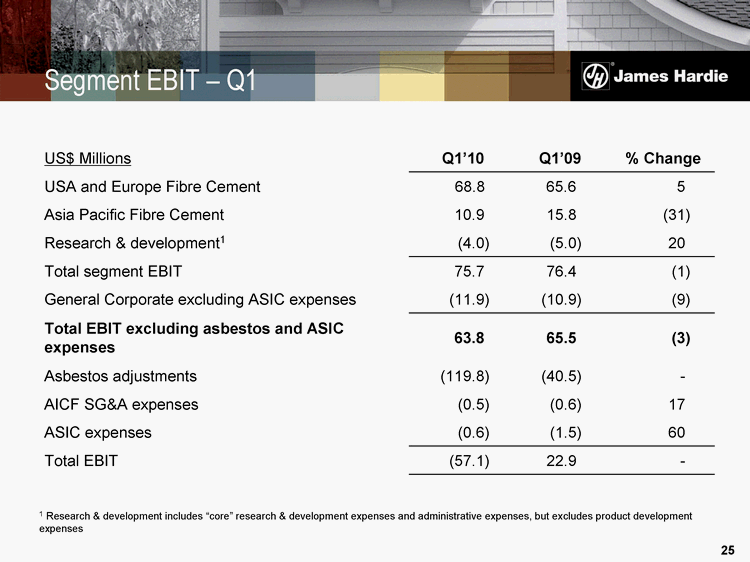
| 25 US$ Millions Q1'10 Q1'09 % Change USA and Europe Fibre Cement 68.8 65.6 5 Asia Pacific Fibre Cement 10.9 15.8 (31) Research & development1 (4.0) (5.0) 20 Total segment EBIT 75.7 76.4 (1) General Corporate excluding ASIC expenses (11.9) (10.9) (9) Total EBIT excluding asbestos and ASIC expenses 63.8 65.5 (3) Asbestos adjustments (119.8) (40.5) - AICF SG&A expenses (0.5) (0.6) 17 ASIC expenses (0.6) (1.5) 60 Total EBIT (57.1) 22.9 - 1 Research & development includes "core" research & development expenses and administrative expenses, but excludes product development expenses Segment EBIT - Q1 |
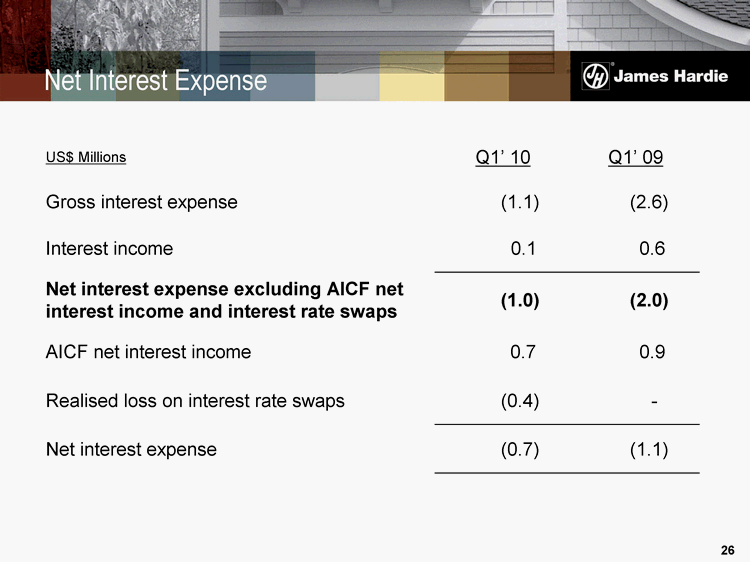
| 26 US$ Millions Q1' 10 Q1' 09 Gross interest expense (1.1) (2.6) Interest income 0.1 0.6 Net interest expense excluding AICF net interest income and interest rate swaps (1.0) (2.0) AICF net interest income 0.7 0.9 Realised loss on interest rate swaps (0.4) - Net interest expense (0.7) (1.1) Net Interest Expense |

| 27 At 30 June 2009: Total principal of interest rate swap contracts of US$250.0 million weighted average fixed interest rate of 2.49% per annum weighted average remaining life is 3.6 years Unrealised gain of US$4.4 million recorded in Consolidated Statement of Operations in Other Income Realised loss for the first three months FY2010 of US$0.4 million Interest Rate Swaps |

| 28 Income Tax Expense - Q1 US$ Millions Q1'10 Q1'09 Operating (loss) profit before income taxes (53.0) 21.8 Asbestos: Asbestos adjustments 119.8 40.5 AICF SG&A expenses 0.5 0.6 AICF interest income (0.7) (0.9) Gain on AICF investments (0.4) - Operating profit before income taxes excluding asbestos 66.2 62.0 Income tax expense (24.9) (20.4) Tax adjustments (0.3) (3.1) Income tax expense excluding asbestos and tax adjustments (25.2) (23.5) Effective tax rate excluding asbestos and tax adjustments 38.1% 37.9% |

| 29 US$ Millions Q1'10 Q1'09 % Change Stock compensation expense 2.0 2.0 - ASIC expenses 0.6 1.5 60 Other costs 5.4 8.7 38 General corporate costs excluding domicile change related costs 8.0 12.2 34 Domicile change related costs 4.5 0.2 - Total corporate costs 12.5 12.4 (1) Corporate Costs - Q1 |
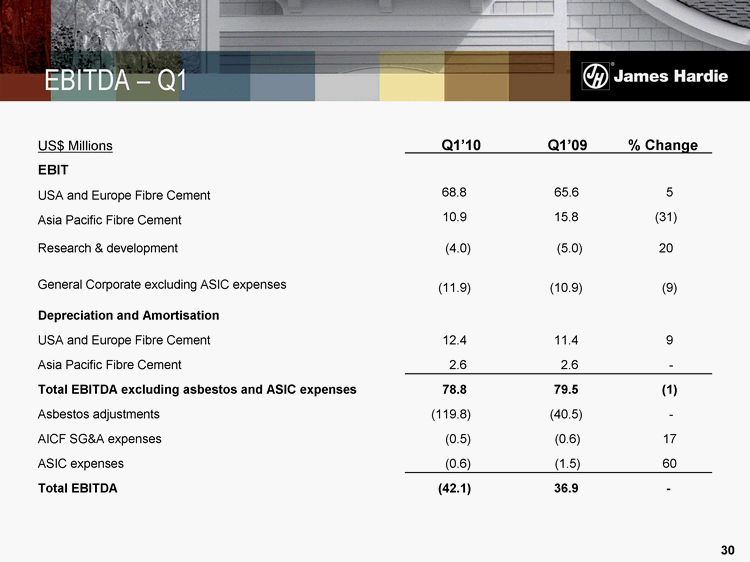
| 30 US$ Millions Q1'10 Q1'09 % Change EBIT USA and Europe Fibre Cement 68.8 65.6 5 Asia Pacific Fibre Cement 10.9 15.8 (31) Research & development (4.0) (5.0) 20 General Corporate excluding ASIC expenses (11.9) (10.9) (9) Depreciation and Amortisation USA and Europe Fibre Cement 12.4 11.4 9 Asia Pacific Fibre Cement 2.6 2.6 - Total EBITDA excluding asbestos and ASIC expenses 78.8 79.5 (1) Asbestos adjustments (119.8) (40.5) - AICF SG&A expenses (0.5) (0.6) 17 ASIC expenses (0.6) (1.5) 60 Total EBITDA (42.1) 36.9 - EBITDA - Q1 |
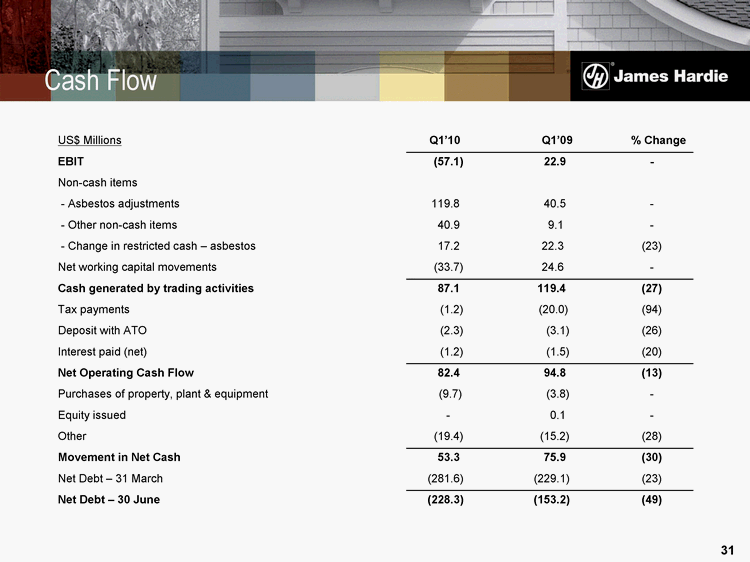
| 31 Cash Flow US$ Millions Q1'10 Q1'09 % Change EBIT (57.1) 22.9 - Non-cash items - Asbestos adjustments 119.8 40.5 - - Other non-cash items 40.9 9.1 - - Change in restricted cash - asbestos 17.2 22.3 (23) Net working capital movements (33.7) 24.6 - Cash generated by trading activities 87.1 119.4 (27) Tax payments (1.2) (20.0) (94) Deposit with ATO (2.3) (3.1) (26) Interest paid (net) (1.2) (1.5) (20) Net Operating Cash Flow 82.4 94.8 (13) Purchases of property, plant & equipment (9.7) (3.8) - Equity issued - 0.1 - Other (19.4) (15.2) (28) Movement in Net Cash 53.3 75.9 (30) Net Debt - 31 March (281.6) (229.1) (23) Net Debt - 30 June (228.3) (153.2) (49) |
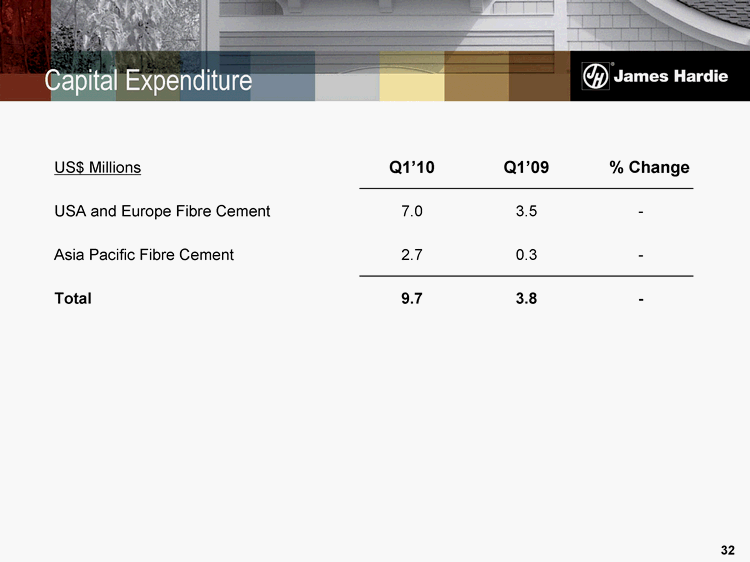
| 32 US$ Millions Q1'10 Q1'09 % Change USA and Europe Fibre Cement 7.0 3.5 - Asia Pacific Fibre Cement 2.7 0.3 - Total 9.7 3.8 - Capital Expenditure |
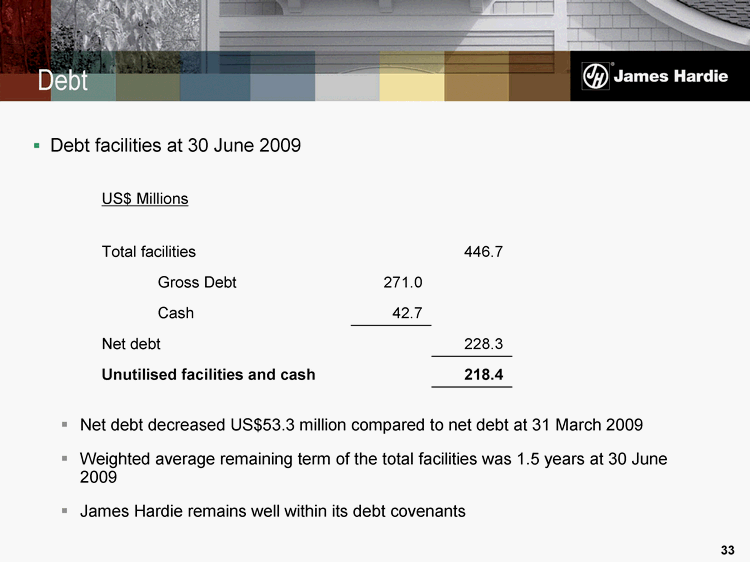
| 33 Debt Net debt decreased US$53.3 million compared to net debt at 31 March 2009 Weighted average remaining term of the total facilities was 1.5 years at 30 June 2009 James Hardie remains well within its debt covenants US$ Millions Total facilities 446.7 Gross Debt 271.0 Cash 42.7 Net debt 228.3 Unutilised facilities and cash 218.4 Debt facilities at 30 June 2009 |
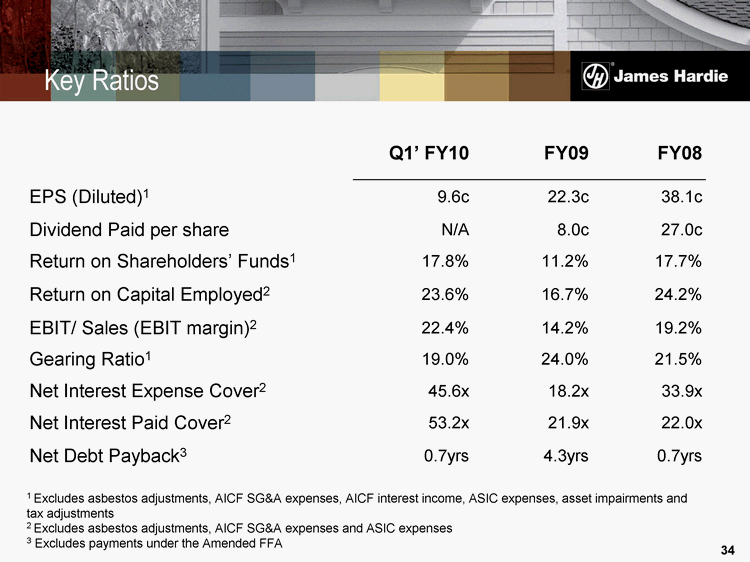
| 34 Key Ratios Q1' FY10 FY09 FY08 EPS (Diluted)1 9.6c 22.3c 38.1c Dividend Paid per share N/A 8.0c 27.0c Return on Shareholders' Funds1 17.8% 11.2% 17.7% Return on Capital Employed2 23.6% 16.7% 24.2% EBIT/ Sales (EBIT margin)2 22.4% 14.2% 19.2% Gearing Ratio1 19.0% 24.0% 21.5% Net Interest Expense Cover2 45.6x 18.2x 33.9x Net Interest Paid Cover2 53.2x 21.9x 22.0x Net Debt Payback3 0.7yrs 4.3yrs 0.7yrs 1 Excludes asbestos adjustments, AICF SG&A expenses, AICF interest income, ASIC expenses, asset impairments and tax adjustments 2 Excludes asbestos adjustments, AICF SG&A expenses and ASIC expenses 3 Excludes payments under the Amended FFA |

| 35 Improved US and Europe EBIT, reflecting lower average unit manufacturing costs, lower freight costs, decreased SG&A spending, improved plant performance and an increase in average net sales price In Australian dollars, Asia Pacific Fibre Cement EBIT for the quarter decreased 13% due to a lower gross margin performance partially offset by lower SG&A expenses Net operating profit excluding asbestos, ASIC expenses and tax adjustments, increased 4% for the quarter, compared to the same period last year Net cash flow from operations remains strong All businesses well-positioned for prevailing operating environment Results remain subject to fluctuation in A$ : US$ exchange rate Summary |
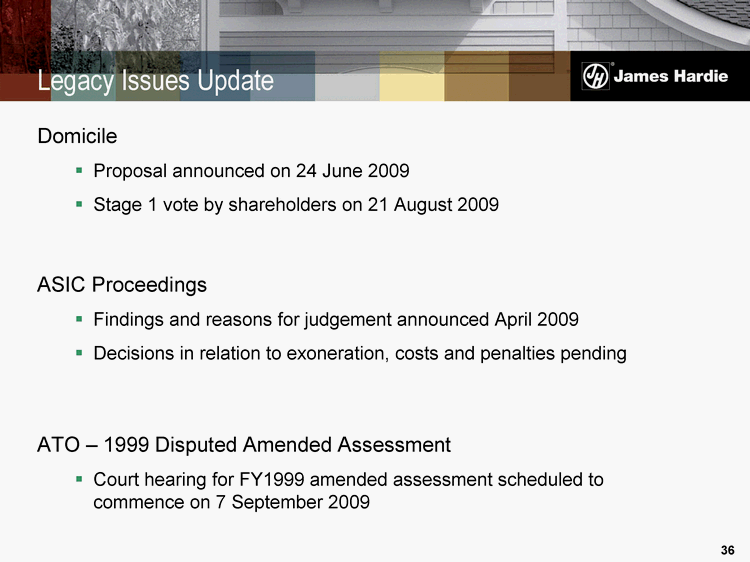
| 36 Legacy Issues Update Domicile Proposal announced on 24 June 2009 Stage 1 vote by shareholders on 21 August 2009 ASIC Proceedings Findings and reasons for judgement announced April 2009 Decisions in relation to exoneration, costs and penalties pending ATO - 1999 Disputed Amended Assessment Court hearing for FY1999 amended assessment scheduled to commence on 7 September 2009 |

| Questions & Answers |
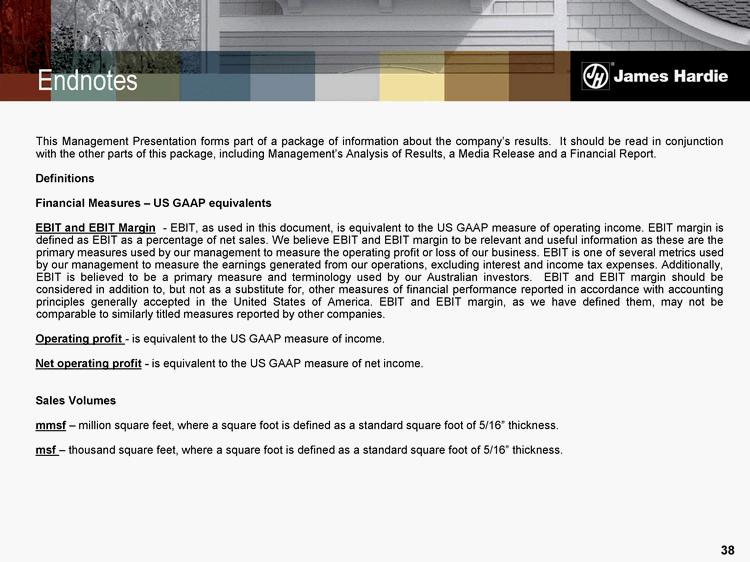
| 38 Endnotes This Management Presentation forms part of a package of information about the company's results. It should be read in conjunction with the other parts of this package, including Management's Analysis of Results, a Media Release and a Financial Report. Definitions Financial Measures - US GAAP equivalents EBIT and EBIT Margin - EBIT, as used in this document, is equivalent to the US GAAP measure of operating income. EBIT margin is defined as EBIT as a percentage of net sales. We believe EBIT and EBIT margin to be relevant and useful information as these are the primary measures used by our management to measure the operating profit or loss of our business. EBIT is one of several metrics used by our management to measure the earnings generated from our operations, excluding interest and income tax expenses. Additionally, EBIT is believed to be a primary measure and terminology used by our Australian investors. EBIT and EBIT margin should be considered in addition to, but not as a substitute for, other measures of financial performance reported in accordance with accounting principles generally accepted in the United States of America. EBIT and EBIT margin, as we have defined them, may not be comparable to similarly titled measures reported by other companies. Operating profit - is equivalent to the US GAAP measure of income. Net operating profit - is equivalent to the US GAAP measure of net income. Sales Volumes mmsf - million square feet, where a square foot is defined as a standard square foot of 5/16" thickness. msf - thousand square feet, where a square foot is defined as a standard square foot of 5/16" thickness. |
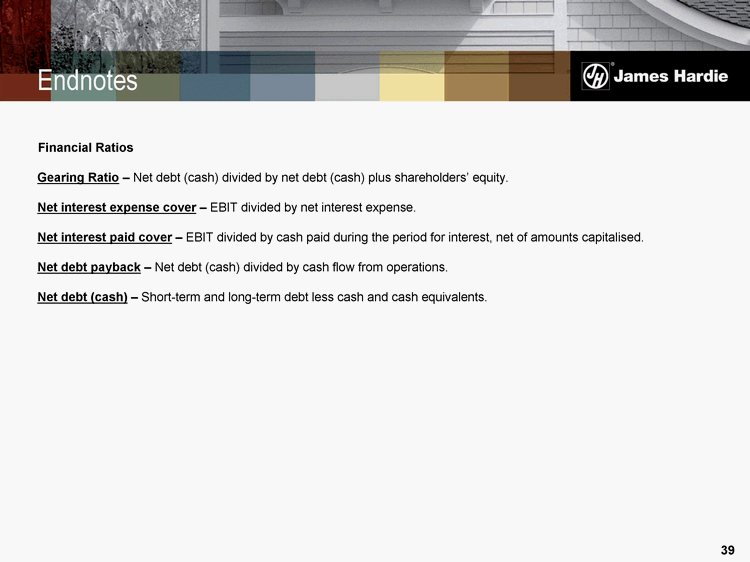
| 39 Endnotes Financial Ratios Gearing Ratio - Net debt (cash) divided by net debt (cash) plus shareholders' equity. Net interest expense cover - EBIT divided by net interest expense. Net interest paid cover - EBIT divided by cash paid during the period for interest, net of amounts capitalised. Net debt payback - Net debt (cash) divided by cash flow from operations. Net debt (cash) - Short-term and long-term debt less cash and cash equivalents. |
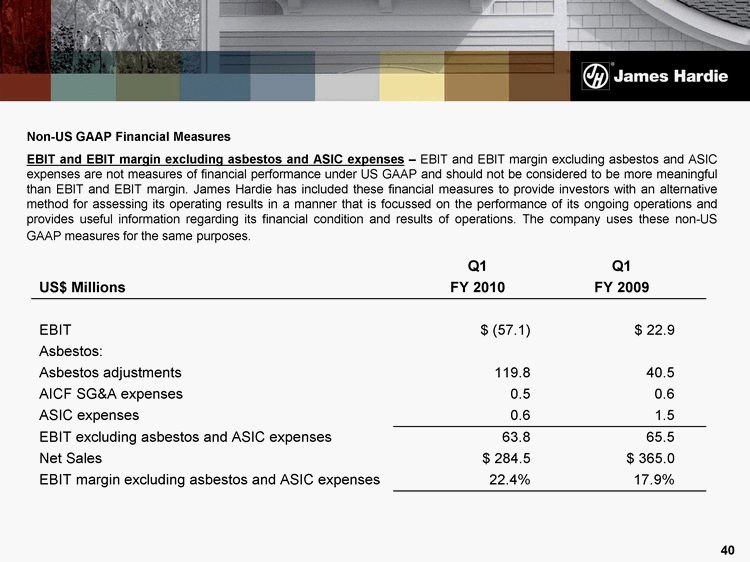
| 40 Non-US GAAP Financial Measures EBIT and EBIT margin excluding asbestos and ASIC expenses - EBIT and EBIT margin excluding asbestos and ASIC expenses are not measures of financial performance under US GAAP and should not be considered to be more meaningful than EBIT and EBIT margin. James Hardie has included these financial measures to provide investors with an alternative method for assessing its operating results in a manner that is focussed on the performance of its ongoing operations and provides useful information regarding its financial condition and results of operations. The company uses these non-US GAAP measures for the same purposes. Q1 Q1 US$ Millions FY 2010 FY 2009 EBIT $ (57.1) $ 22.9 Asbestos: Asbestos adjustments 119.8 40.5 AICF SG&A expenses 0.5 0.6 ASIC expenses 0.6 1.5 EBIT excluding asbestos and ASIC expenses 63.8 65.5 Net Sales $ 284.5 $ 365.0 EBIT margin excluding asbestos and ASIC expenses 22.4% 17.9% |
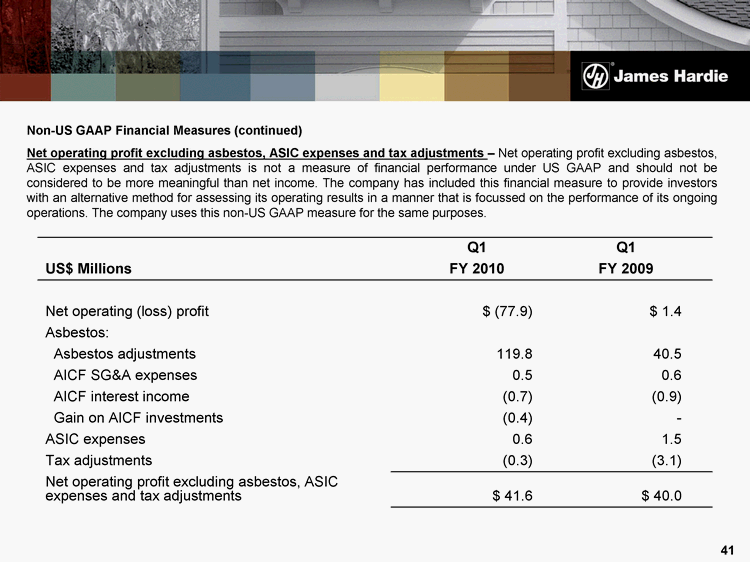
| 41 Non-US GAAP Financial Measures (continued) Net operating profit excluding asbestos, ASIC expenses and tax adjustments - Net operating profit excluding asbestos, ASIC expenses and tax adjustments is not a measure of financial performance under US GAAP and should not be considered to be more meaningful than net income. The company has included this financial measure to provide investors with an alternative method for assessing its operating results in a manner that is focussed on the performance of its ongoing operations. The company uses this non-US GAAP measure for the same purposes. Q1 Q1 US$ Millions FY 2010 FY 2009 Net operating (loss) profit $ (77.9) $ 1.4 Asbestos: Asbestos adjustments 119.8 40.5 AICF SG&A expenses 0.5 0.6 AICF interest income (0.7) (0.9) Gain on AICF investments (0.4) - ASIC expenses 0.6 1.5 Tax adjustments (0.3) (3.1) Net operating profit excluding asbestos, ASIC expenses and tax adjustments $ 41.6 $ 40.0 |
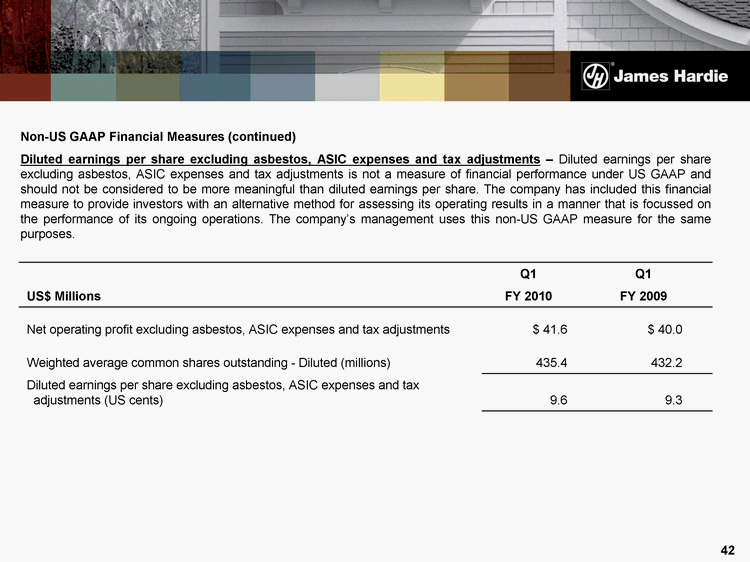
| 42 Non-US GAAP Financial Measures (continued) Diluted earnings per share excluding asbestos, ASIC expenses and tax adjustments - Diluted earnings per share excluding asbestos, ASIC expenses and tax adjustments is not a measure of financial performance under US GAAP and should not be considered to be more meaningful than diluted earnings per share. The company has included this financial measure to provide investors with an alternative method for assessing its operating results in a manner that is focussed on the performance of its ongoing operations. The company's management uses this non-US GAAP measure for the same purposes. Q1 Q1 US$ Millions FY 2010 FY 2009 Net operating profit excluding asbestos, ASIC expenses and tax adjustments $ 41.6 $ 40.0 Weighted average common shares outstanding - Diluted (millions) 435.4 432.2 Diluted earnings per share excluding asbestos, ASIC expenses and tax adjustments (US cents) 9.6 9.3 |
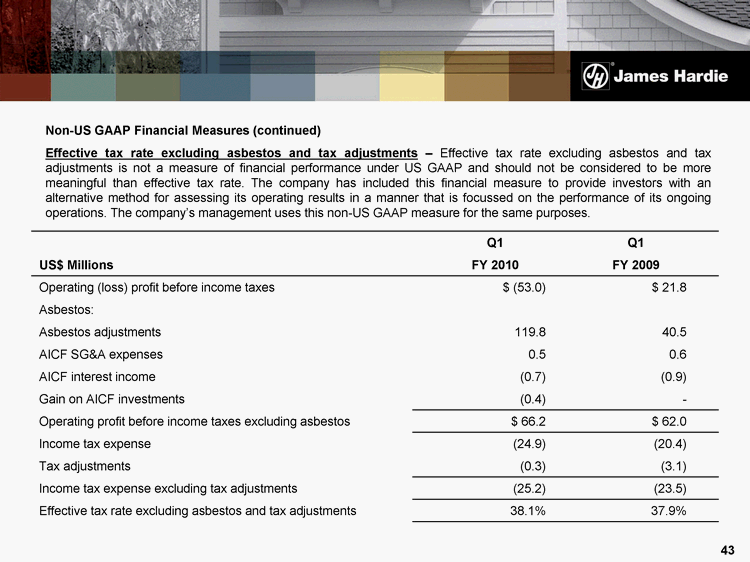
| 43 Non-US GAAP Financial Measures (continued) Effective tax rate excluding asbestos and tax adjustments - Effective tax rate excluding asbestos and tax adjustments is not a measure of financial performance under US GAAP and should not be considered to be more meaningful than effective tax rate. The company has included this financial measure to provide investors with an alternative method for assessing its operating results in a manner that is focussed on the performance of its ongoing operations. The company's management uses this non-US GAAP measure for the same purposes. Q1 Q1 US$ Millions FY 2010 FY 2009 Operating (loss) profit before income taxes $ (53.0) $ 21.8 Asbestos: Asbestos adjustments 119.8 40.5 AICF SG&A expenses 0.5 0.6 AICF interest income (0.7) (0.9) Gain on AICF investments (0.4) - Operating profit before income taxes excluding asbestos $ 66.2 $ 62.0 Income tax expense (24.9) (20.4) Tax adjustments (0.3) (3.1) Income tax expense excluding tax adjustments (25.2) (23.5) Effective tax rate excluding asbestos and tax adjustments 38.1% 37.9% |
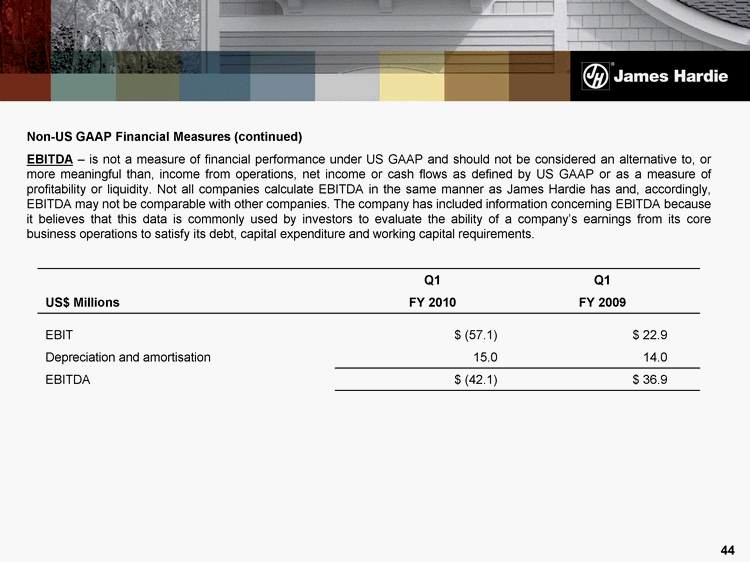
| 44 Non-US GAAP Financial Measures (continued) EBITDA - is not a measure of financial performance under US GAAP and should not be considered an alternative to, or more meaningful than, income from operations, net income or cash flows as defined by US GAAP or as a measure of profitability or liquidity. Not all companies calculate EBITDA in the same manner as James Hardie has and, accordingly, EBITDA may not be comparable with other companies. The company has included information concerning EBITDA because it believes that this data is commonly used by investors to evaluate the ability of a company's earnings from its core business operations to satisfy its debt, capital expenditure and working capital requirements. Q1 Q1 US$ Millions FY 2010 FY 2009 EBIT $ (57.1) $ 22.9 Depreciation and amortisation 15.0 14.0 EBITDA $ (42.1) $ 36.9 |
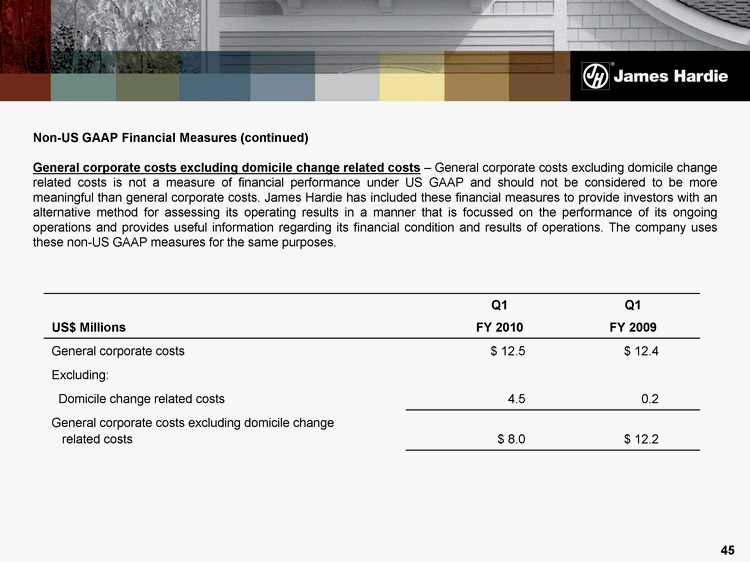
| 45 Non-US GAAP Financial Measures (continued) General corporate costs excluding domicile change related costs - General corporate costs excluding domicile change related costs is not a measure of financial performance under US GAAP and should not be considered to be more meaningful than general corporate costs. James Hardie has included these financial measures to provide investors with an alternative method for assessing its operating results in a manner that is focussed on the performance of its ongoing operations and provides useful information regarding its financial condition and results of operations. The company uses these non-US GAAP measures for the same purposes. Q1 Q1 Q1 Q1 US$ Millions FY 2010 FY 2010 FY 2009 FY 2009 General corporate costs $ 12.5 $ 12.4 Excluding: Domicile change related costs 4.5 0.2 General corporate costs excluding domicile change related costs $ 8.0 $ 12.2 |
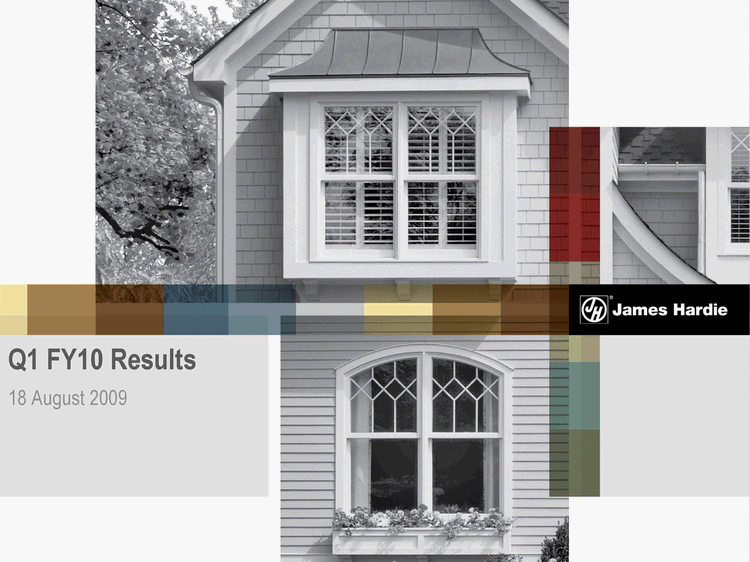
| 18 August 2009 Q1 FY10 Results |